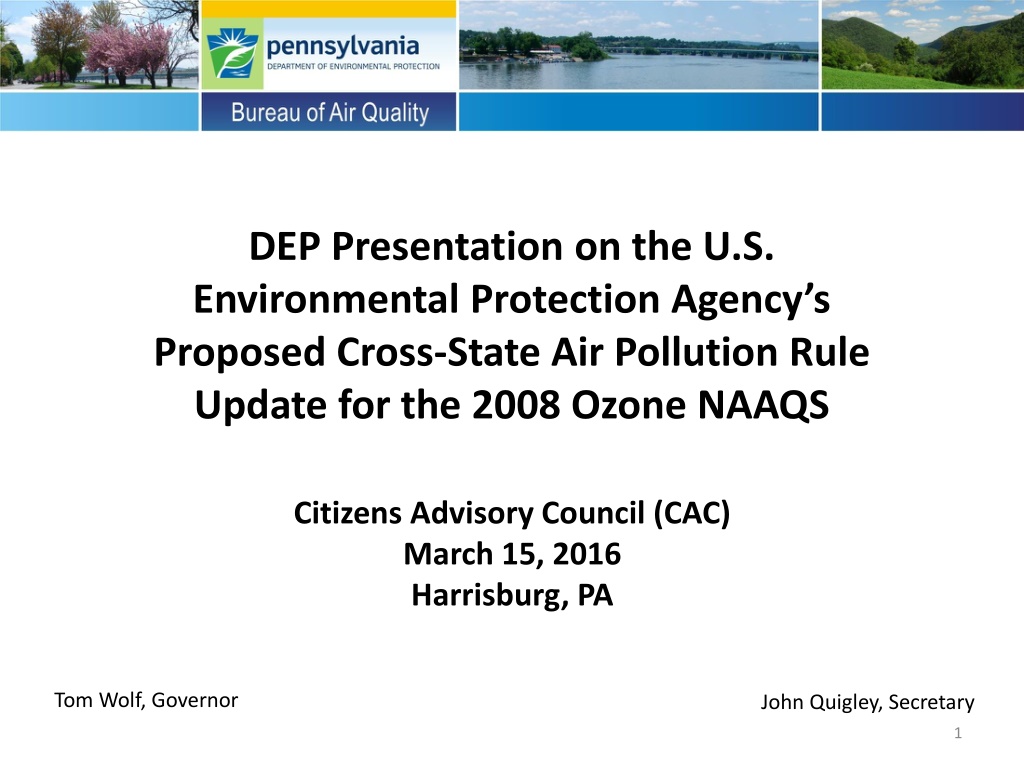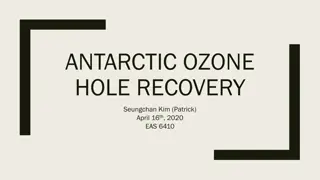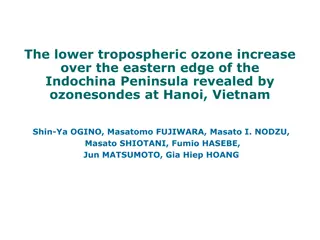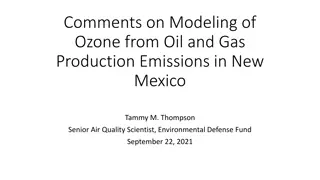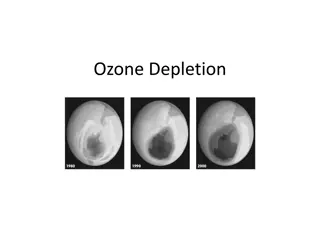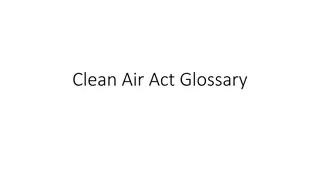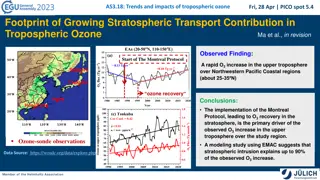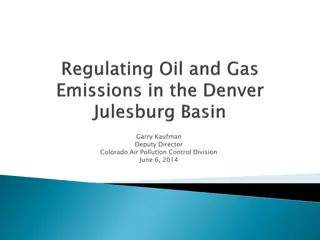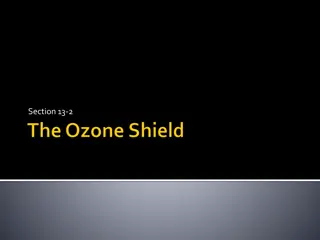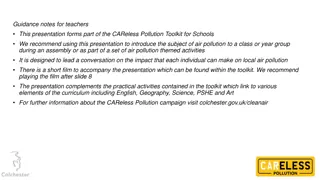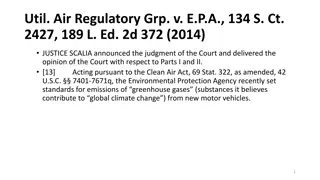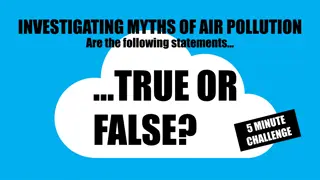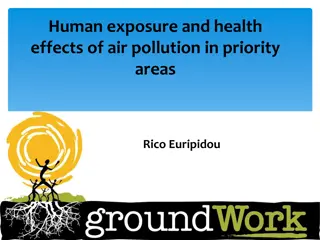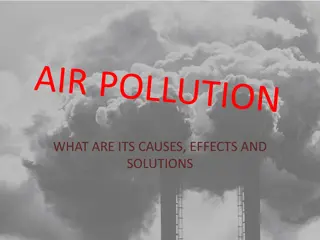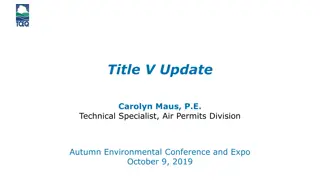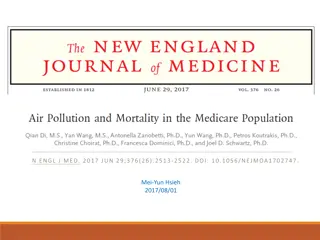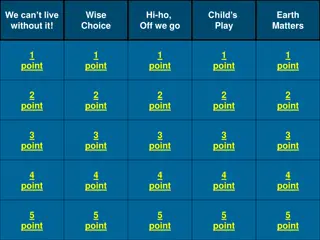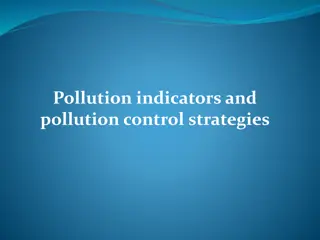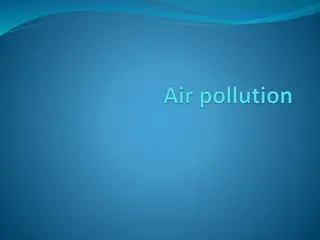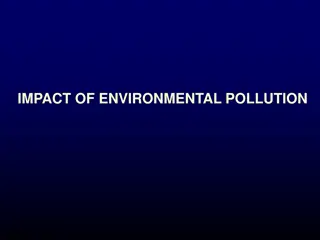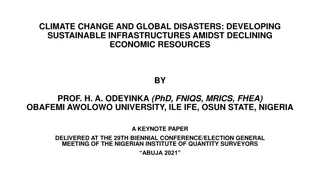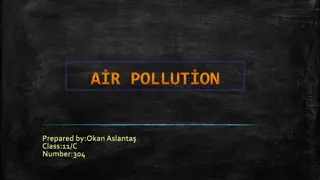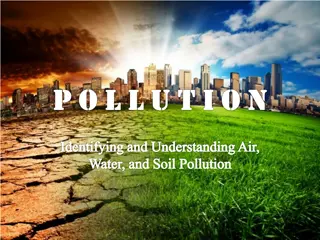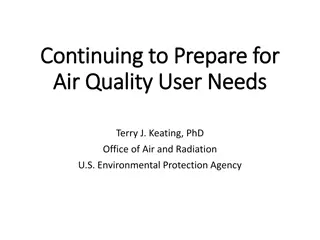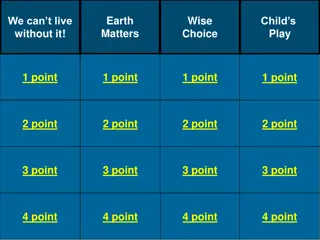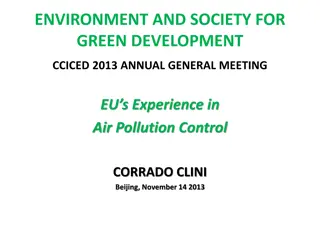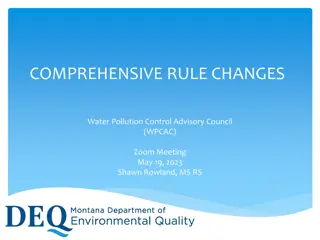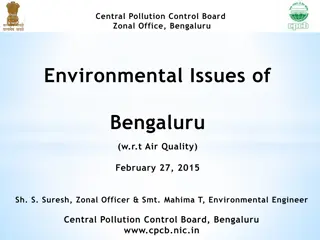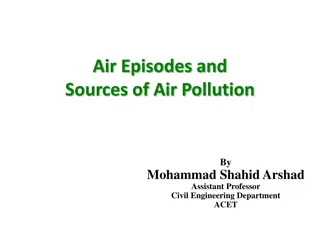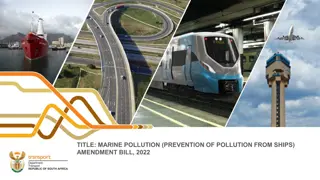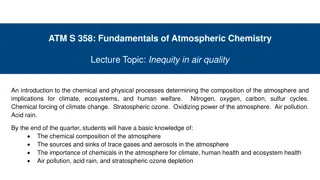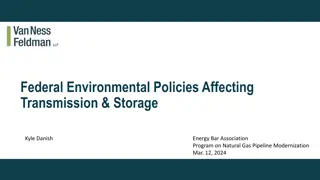U.S. EPA's Proposed Cross-State Air Pollution Rule Update for 2008 Ozone NAAQS
The U.S. Environmental Protection Agency (EPA) issued the Cross-State Air Pollution Rule (CSAPR) in 2011, aiming to improve air quality by reducing power plant emissions across state lines. Challenges and subsequent revisions led to the proposed CSAPR Update Rule in 2015, targeting interstate air pollutant transport that affects the 2008 ozone National Ambient Air Quality Standards. The proposed rule focuses on limiting nitrogen oxide emissions from Electric Generating Units in 23 eastern states to combat nonattainment of ozone NAAQS.
Download Presentation

Please find below an Image/Link to download the presentation.
The content on the website is provided AS IS for your information and personal use only. It may not be sold, licensed, or shared on other websites without obtaining consent from the author. Download presentation by click this link. If you encounter any issues during the download, it is possible that the publisher has removed the file from their server.
E N D
Presentation Transcript
DEP Presentation on the U.S. Environmental Protection Agency s Proposed Cross-State Air Pollution Rule Update for the 2008 Ozone NAAQS Citizens Advisory Council (CAC) March 15, 2016 Harrisburg, PA Tom Wolf, Governor John Quigley, Secretary 1
History of EPAs CSAPR and CSAPR Update Proposed Rulemaking The U.S. Environmental Protection Agency (EPA) issued the Cross-State Air Pollution Rule (CSAPR) in July 2011. As amended, CSAPR required 28 states in the eastern half of the United States to significantly improve air quality by reducing power plant emissions that cross state lines and contribute to ozone and fine particle pollution in other states. CSAPR was scheduled to replace the Clean Air Interstate Rule beginning January 1, 2012. 2
History of EPAs CSAPR and CSAPR Update Proposed Rulemaking A number of petitioners challenged CSAPR in the D.C. Circuit in EME Homer City v. EPA (Case No. 11-1302). The D.C. Circuit subsequently issued decisions that stayed and then vacated the CSAPR rule before implementation began. On April 29, 2014, the U.S. Supreme Court reversed the D.C. Circuit s vacatur. The April 2014 U.S. Supreme Court decision also remanded the CSAPR litigation to the D.C. Circuit. On October 23, 2014, the D.C. Circuit granted the EPA s motion to lift the stay and shift the CSAPR compliance deadlines by three years. 3
History of EPAs CSAPR and CSAPR Update Proposed Rulemaking The EPA issued an interim final rule revising the compliance deadlines in its regulations, and the CSAPR Phase I implementation began on January 1, 2015, for the annual programs and May 1, 2015, for the ozone season program, with Phase II to begin in 2017. On June 30, 2015, the EPA issued a final notice finding that a number of states failed to submit good neighbor SIPs for the 2008 ozone standard. These findings established a 2-year deadline for the EPA to either approve an SIP or finalize an FIP that addresses the good neighbor requirement. On July 28, 2015, the D.C. Circuit remanded the ozone season budgets for 11 states to the EPA for reconsideration. 4
Overview of EPAs CSAPR Update Proposed Rulemaking On November 16, 2015, the EPA proposed an update to the Cross-State Air Pollution Rule (CSAPR) for the 2008 ozone National Ambient Air Quality Standards (NAAQS) by issuing the proposed CSAPR Update Rule. On December 3, 2015, the Cross-State Air Pollution Rule Update for the 2008 Ozone NAAQS was published in the Federal Register(80 FR 75706). The EPA proposed that the CSAPR Update Rule will reduce interstate air pollutant emission transport that significantly contributes to nonattainment, or interferes with maintenance, of the 2008 ozone NAAQS in the eastern U.S. To achieve this goal, the proposed CSAPR Update Rule would further limit ozone season (May 1 through September 30) nitrogen oxide (NOX) emissions from Electric Generating Units (EGUs) in 23 eastern states. 5
Overview of EPAs CSAPR Update Proposed Rulemaking - States Affected 6
Overview of EPAs CSAPR Update Proposed Rulemaking The EPA s proposed CSAPR Update Rule also responds to the July 2015 remand of certain CSAPR NOX emissions budgets by the United States Court of Appeals for the D.C. Circuit. In response to the D.C. Circuit remand in EME Homer City, the EPA proposed the CSAPR Update Rule to replace the existing Phase II CSAPR ozone season NOX emissions budgets for nine states (Maryland, New Jersey, New York, North Carolina, Ohio, Pennsylvania, Texas, Virginia, and West Virginia) with updated budgets designed to address interstate transport with respect to the 2008 ozone NAAQS. The EPA also proposed to remove two states (South Carolina and Florida) from the CSAPR ozone season NOX trading program. 7
Impact of EPAs CSAPR Update Proposed Rulemaking The EPA anticipates, starting in 2017, that the CSAPR Update Rule will reduce summertime NOX emissions from power plants in 23 states in the eastern U.S. and provide up to $1.2 billion in health benefits to millions of Americans. The EPA predicts that the effects of this proposed rule on employment and retail electricity prices will be modest and vary year by year. The EPA analysis shows small employment gains and losses in both the electricity generation and fuels sectors as some companies upgrade and optimize existing NOX pollution control equipment to comply with the proposed rule. Some electricity generation is shifted from coal-fired EGUs to gas-fired units. 8
Other NAAQS and the CSAPR Update Proposed Rulemaking The annual PM2.5 NAAQS was updated in 2012 after CSAPR was promulgated (78 FR 306, January 15, 2013). The CSAPR Update proposed rule does not address the 2012 PM2.5 standard. The EPA acknowledges that, in EME Homer City II, the D.C. Circuit also remanded without vacatur the CSAPR Phase II SO2 emissions budgets for four states (Alabama, Georgia, South Carolina, and Texas) The proposal does not address the remand of these CSAPR Phase II SO2 annual emissions budgets which will be addressed separately by EPA. The existing CSAPR emissions budgets and implementation programs for annual SO2 and NOX requirements, which address interstate transport for the 1997 and 2006 PM2.5 NAAQS, continue to apply at this time. 9
Largest Contributions by State Upwind State Largest Downwind Contribution to Nonattainment Receptors for Ozone (ppb) Largest Downwind Contribution to Maintenance Receptors for Ozone (ppb) Upwind State Largest Downwind Contribution to Nonattainment Receptors for Ozone (ppb) Largest Downwind Contribution to Maintenance Receptors for Ozone (ppb) AL 0.79 1.28 KS 0.80 1.03 AR 0.98 2.15 KY 0.75 11.17 CT 0.00 0.46 LA 3.09 4.23 DE 0.37 2.23 ME 0.00 0.08 DC 0.06 0.73 MD 2.07 7.11 FL 0.54 0.72 MA 0.10 0.37 GA 0.47 0.58 MI 2.69 1.79 IL 17.48 23.17 MN 0.40 0.47 IN 6.24 14.95 MS 0.78 1.48 IA 0.61 0.85 10
Largest Contributions by State Upwind State Largest Downwind Contribution to Nonattainment Receptors for Ozone (ppb) Largest Downwind Contribution to Maintenance Receptors for Ozone (ppb) Upwind State Largest Downwind Contribution to Nonattainment Receptors for Ozone (ppb) Largest Downwind Contribution to Maintenance Receptors for Ozone (ppb) MO 1.63 3.69 RI 0.02 0.08 NE 0.24 0.36 SC 0.16 0.21 NH 0.02 0.07 SD 0.08 0.12 NJ 8.84 12.38 TN 0.51 1.67 NY 16.96 17.21 TX 2.44 2.95 NC 0.55 0.93 VT 0.01 0.05 ND 0.11 0.28 VA 1.87 5.29 OH 2.18 7.92 WV 0.95 3.11 OK 1.70 2.46 WI 0.34 2.59 PA 9.39 15.93 11
Proposed Ozone Season NOX Emission Budgets by State State EGU NOX Ozone Season Emissions Budgets Variability Limits EGU NOX Ozone Season Assurance Levels State EGU NOX Ozone Season Emissions Budgets Variability Limits EGU NOX Ozone Season Assurance Levels Alabama 9,979 2,096 12,075 Michigan 19,115 4,014 23,129 Arkansas 6,949 1,459 8,408 Mississippi 5,910 1,241 7,151 Illinois 12,078 2,536 14,614 Missouri 15,323 3,218 18,541 Indiana 28,284 5,940 34,224 New Jersey 2,015 423 2,438 Iowa 8,351 1,754 10,105 New York 4,450 935 5,385 Kansas 9,272 1,947 11,219 North Carolina 12,275 2,578 14,853 Kentucky 21,519 4,519 26,038 Ohio 16,660 3,499 20,159 Louisiana 15,807 3,319 19,126 Oklahoma 16,215 3,405 19,620 Maryland 4,026 845 4,871 12
Proposed Ozone Season NOX Emission Budgets by State State EGU NOX Ozone Season Emissions Budgets Variability Limits EGU NOX Ozone Season Assurance Levels Pennsylvania 14,387 3,021 17,408 Tennessee 5,481 1,151 6,632 Texas 58,002 12,180 70,182 Virginia 6,818 1,432 8,250 West Virginia 13,390 2,812 16,202 Wisconsin 5,561 1,168 6,729 Region Cap 311,867 65,493 13
Impact of EPAs proposed NOX Budgets The EPA s proposed CSAPR Update NOX budgets result in the following reductions, by state: Connecticut not part of CSAPR Maryland 44% reduction New Jersey 46% reduction New York 57% reduction Ohio 57% reduction Pennsylvania 72% reduction Virginia 52% reduction West Virginia 42% reduction 14
PA DEP Comments on CSAPR Update Proposed Rulemaking The CSAPR Update proposed rulemaking provided for a public comment period ending January 19, 2016. The EPA extended the comment period on December 29, 2015, to a 60-day public comment period which ended on February 1, 2016 (80 FR 81251). PA DEP submitted comments on several aspects of the proposed CSAPR Update, including the following: The cost thresholds used by the EPA to develop the State NOX Budgets; The timing and compliance requirements; Shifting electricity generation to lower NOX-emitting EGUs; The EPA s proposed Banked Allowance Surrender Ratio. 15
PA DEP Comments on CSAPR Update Proposed Rulemaking DEP supports the EPA s use of the following four-step analytical process: (1) Identify downwind receptors that are expected to have problems attaining or maintaining NAAQS; (2) Determine which upwind states contribute to these identified problems; (3) Identify upwind emissions that significantly contribute to downwind nonattainment or interfere with maintenance and quantify the available upwind emission reductions and apportion the upwind responsibility among the linked states; (4) States found to significantly contribute to nonattainment or interfere with maintenance will reduce the identified upwind emissions via regional emissions allowance trading programs. 16
PA DEP Comments on CSAPR Update Proposed Rulemaking DEP commented on the EPA s evaluation of its cost thresholds analysis and the need to consider PA s RACT II emission limits. The EPA used a 50 percent analysis for setting NOx reduction cost thresholds for existing selective catalytic reduction (SCR) systems. For example, installed SCRs on EGUs can operate in a range of $350 -$750 per ton of NOx reduction. Fifty percent of the $350 - $750 range is $500 per ton of NOx reduced. DEP urged the EPA to consider the NOx emission limitations for the EGU sector in the PA final-form RACT regulation when establishing the final NOx ozone season trading budget for PA in the CSAPR Update Rule. The next slide shows a table of the EPA s assumed cost thresholds. 17
EPA NOx Cost Thresholds EGU NOX Cost Threshold $500/ton CSAPR ozone season NOX cost threshold; fully operating post-combustion controls that are already running $1,300/ton Widespread availability of restarting idled SCRs and state of the art combustion controls $3,400/ton NOX SIP Call ozone season NOX cost threshold, adjusted to 2014$; widespread availability of restarting idled SNCRs $5,000/ton Widespread availability of new SCRs $6,400/ton Widespread availability of new SNCRs $10,000/ton Upper bound 18
PA DEP Comments on CSAPR Update Proposed Rulemaking PA DEP comments on the EPA s evaluation of its cost threshold analysis. The EPA s $500 per ton of NOx cost threshold for operating existing SCR is too low. PA DEP suggests EPA use cost thresholds of $800 - $1,000 per ton NOx which is slightly above the $750 at the top end of its assumptions. The $1,300 per ton cost threshold does not consider technical limitations of SCR controls when EGUs operate at lower capacity. PA DEP suggests the cost threshold for bringing SCRs back on line is higher than $1,300 per ton, and the NOx reductions should be based upon on $800 - $1000 per ton. 19
PA DEP Comments on CSAPR Update Proposed Rulemaking PA DEP comments on the Technical Infeasibility of Meeting the Proposed Allocations. The EPA s analysis assumes NOx emission reductions are readily available by 2017 through the optimization and operation of controls. Affected EGUs would be required to meet a statewide average emissions rate of 0.057 lbs/MMBtu of NOx of heat input based upon the EPA s proposed Ozone Season NOx Budget for PA. The existing controls will not be able to meet the average emissions rates assumed by the EPA. Therefore, EGU owners and operators would need to purchase NOx allowances to achieve compliance. It is not technically feasible to operate SCRs properly when EGUs are operated at low temperatures and low operating capacities during the night-time hours. 20
PA DEP Comments on CSAPR Update Proposed Rulemaking PA DEP comments on special consideration for Coal Refuse-Fired Facilities. Pennsylvania has 184,000 acres of unclaimed mining area filled with coal refuse. Coal refuse piles cause acid mine drainage and sometimes catch fire and cause air emissions. Pennsylvania has 15 coal refuse facilities that beneficially use 12 million tons of waste coal annually and restore these degraded unclaimed mining areas. PA DEP s comments to the EPA point out that these waste coal facilities provide great benefits to PA and its residents and that they are an insignificant portion of the pollution transported to other states. PA suggested that the EPA tailor the final CSAPR Update to ensure the waste coal refuse units can continue to operate and generate environmental benefits for PA. 21
PA DEP Comments on CSAPR Update Proposed Rulemaking PA DEP comments on shifting generation to Lower NOx emitting EGUs. The EPA indicates in its analysis that high NOx emitting generators will also be able to shift generation to lower emitting generation as lower emitting generation is in place and that investment has already been made. PA DEP does not agree with the EPA s premise and suggests that the EPA reconsider this position. The Department believes it is just as likely for generation to shift to higher emitting small EGUs, demand response, and high electric demand day units that are not regulated by CSAPR. 22
PA DEP Comments on CSAPR Update Proposed Rulemaking PA DEP comments on banking and retirement of banked NOx allowances. The EPA s use of a NOx allowance retirement ratio for facilities that comply with CSAPR through the use of banked allowances was not supported by PA DEP because banked NOx allowances allow facilities to address operational variability. The EPA asked for comments on ratios such as 2:1 and 4:1 to reduce the size of the NOx allowance bank. These high NOx allowance retirement ratios could create instability in the allowance market and cause large price swings or ozone season allowance shortages under some conditions. DEP did indicate that a banked NOx allowance cap could be used to address the large number of allowances in the allowance bank or the EPA could just allow old allowances to expire. 23
PA DEP Comments on CSAPR Update Proposed Rulemaking PA DEP comments on EPA s Non-EGU NOx Mitigation Strategies. The EPA requests comment on two issues associated with NOx mitigation from non-EGUs: The EPA indicates it will continue to evaluate whether non-EGUs emission reductions can be made at a later date and ask for comment on its preliminary evaluation; The EPA asks for comment on allowing legacy non-EGUs to participate in the CSAPR program. The CSAPR Update only provides a partial remedy to address ozone transport to downwind states. The EPA needs to address NOx emissions from non-EGUs as part of its strategy. Non-EGUs can contribute to transport issues even if the EGUs in a state do not. There may be cost-effective NOx reductions available from non-EGUs which the EPA does not address. The good neighbor provisions in the CAA apply to all sources not, just EGUs. 24
PA DEP Comments on CSAPR Update Proposed Rulemaking PA DEP comments on the EPA s Non-EGU NOx Mitigation Strategies. PA DEP recommended that legacy non-EGUs should continue to be included in the CSAPR trading program. PA DEP submitted comments on the EPA s request for comment on future steps needed to resolve the good neighbor obligations: NOx emissions could be capped across all sectors based upon achievable emission rates, with the option to buy CSAPR allowances to meet compliance obligations. This would also help address the size of the NOx allowance banks. 25
PA DEP Comments on CSAPR Update Proposed Rulemaking Comments made by PA DEP can be reviewed on the EPA Docket at http://www.regulations.gov Docket No. EPA-HQ-OAR-2015-0500 Questions? 26
Contact Information: Randy Bordner at ranbordner@pa.gov 717-772-3921 Krishnan Ramamurthy at kramamurthy@pa.gov 717-783-9476 27
